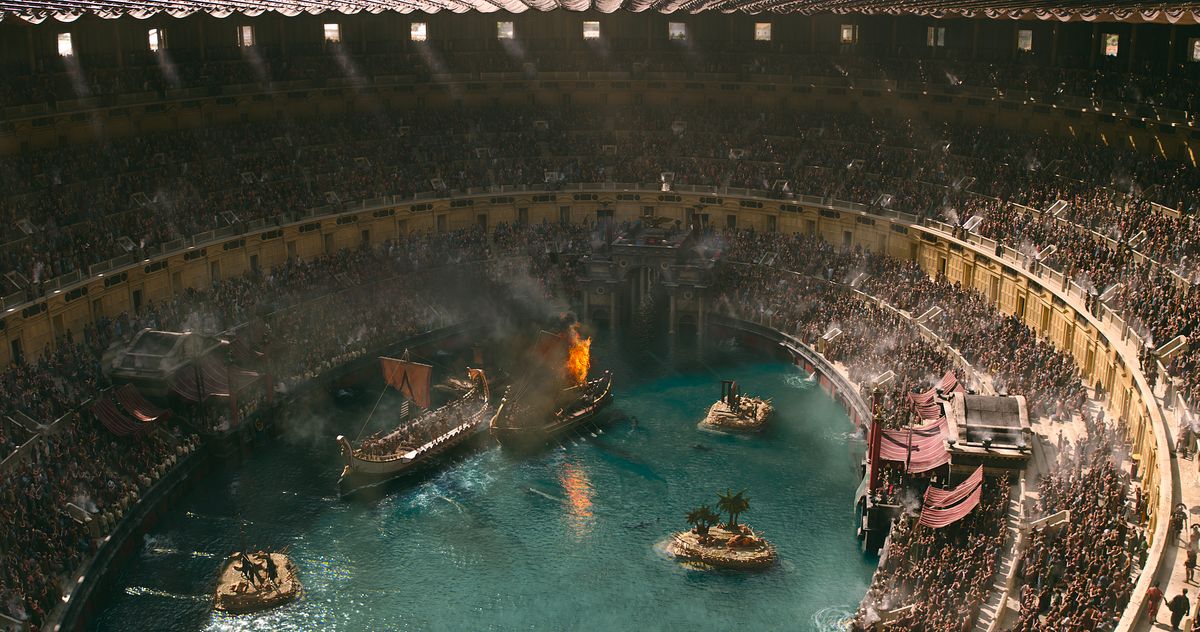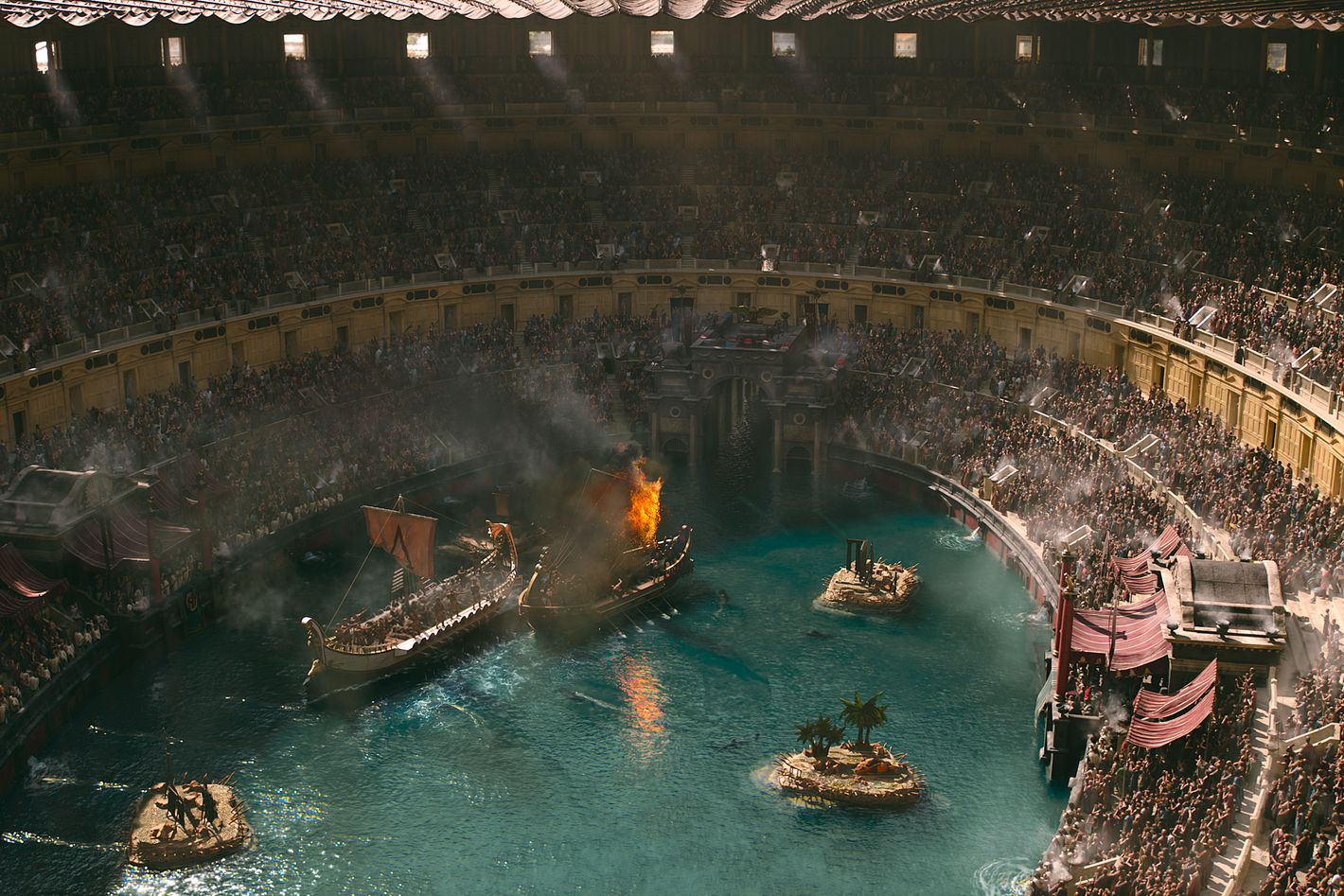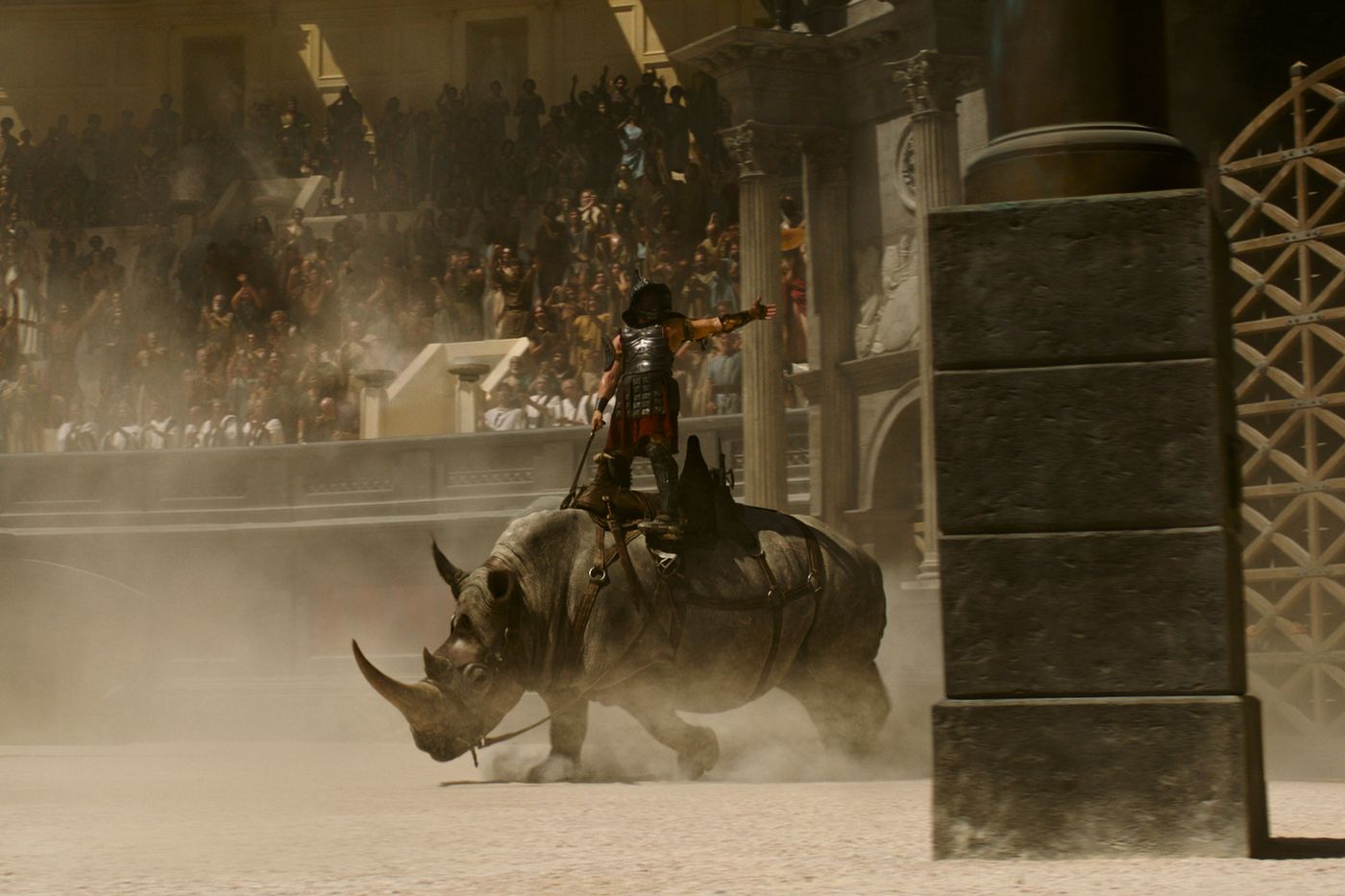Ask a Roman-History Professor: Were There Ever Sharks in the Colosseum?
Gladiator II director Ridley Scott famously does not care about historical accuracy in his films but we had to ask.


To paraphrase Cher Horowitz, searching for historical accuracy in a Ridley Scott film is as useless as searching for meaning in a Pauly Shore movie. That’s not a knock against the entertainment value or even the overall quality of Scott’s work — he just famously does not care. During the press tour for 2023’s Napoleon, the filmmaker made a number of pointed remarks against historians who were quibbling with perceived mistakes. “Get a life,” Scott said in a New Yorker profile. In a different interview with the Sunday Times, the director offered, “When I have issues with historians, I ask: ‘Excuse me, mate, were you there? No? Well, shut the fuck up then.’”
With that in mind, it’s no surprise that Scott’s latest film, Gladiator II, has riled up professional historians and amateur Roman-history nerds alike. Since the first trailer was released, there has been pushback over some of the imagery on display — a gladiator rides a rhino! — and the full two-and-a-half-hour film is unlikely to assuage the historical-accuracy concerns. Audiences just looking for a good time at the movies may be as unbothered as Scott about this stuff. But it’s still interesting to talk about with a historian, even if, as Scott has pointed out, they weren’t there at the time.
To try to separate fact from fiction, I spoke with Chris Epplett, who teaches ancient Greek and Roman history at the University of Lethbridge. One of his main areas of interest is the exotic animal spectacles (venationes) of the Roman arena, and he wrote the 2017 book Gladiators: Deadly Arena Sports of Ancient Rome. I figured that would make him uniquely qualified to answer some of my big questions, though he cautioned that he had not yet seen Gladiator II. He did very patiently listen to my descriptions of key scenes and plot points and never once commented on my butchered pronunciation of Roman names.
Spoilers ahead for the film (and for ancient Roman history).
I think the biggest question everyone I know who has seen Gladiator II comes away with is that, in one of the gladiatorial games, they re-create a naval battle and they have sharks in the water: Were there ever sharks in the Colosseum?
Not that I am aware of, no. Early on in the Colosseum’s history, there was a period when they could have flooded the floor of the arena. There was basically a period of, I think, ten to 20 years before they put the full basement in, when they could have flooded the floor and had exhibitions with marine animals and that sort of thing. They would also sometimes use ponds or manmade pools outside the Colosseum for various nautical events. But yeah, to my recollection, the Romans never had sharks.
Okay, yeah. I mean, the flooding was one thing; the sharks felt like a bridge too far.
Yeah, that would be my opinion. Marine spectacles are well attested. They had seals periodically, we know that. But I’ve never come across sharks in my research.
In the film, a lot of animals featured in combat. Would a gladiator ever have ridden a rhino?
Again, not that I am aware of. I’ve seen that clip. I mean, that looks awesome. And there were rhinoceroses periodically in the Colosseum; actually, they predate the Colosseum. The first rhino to appear in Rome was in the Late Republic, just over a century before the Colosseum was built. But in my research, I’ve never come across mention of anyone riding a rhino. In fact, I don’t know historically if that’s ever been done. I have the impression they’re rather temperamental animals, so I can’t imagine that trying to ride one would go well for the prospective jockey.
The other animal that makes a big impression is the mangy baboon that Paul Mescal’s character, Lucius, has to fight in his first battle. Have you heard of baboons being used?
No. Now, there is a record, more broadly speaking, of the Romans keeping monkeys as pets. This may be a flaw in my memory, but I can’t think offhand of monkeys appearing in the arena. Certainly not in violent spectacles.
Well, in Gladiator II, Emperor Caracalla does have a pet monkey, a capuchin, that he’s very fond of. So that sounds more like something that could have happened.
That’s feasible, yeah. I mean, there were even some Roman emperors — and I believe Caracalla as well, if I remember correctly, but certainly the emperor Elagabalus, only a couple years after him — who had pet lions.
Oh wow.
Elagabulus used to play a joke on his guests who stayed over at the palace after a night of debauchery. He would let his tame lions into their rooms at night so the poor people would wake up in the morning and the first thing they would see would be a lion staring into their face and, you know, frightening them half to death. It’s sort of like the bit in The Hangover when they find the tiger in their hotel room. So yeah, a pet monkey, in and of itself, wouldn’t be implausible.
Lucius ends up being trained as a gladiator by Denzel Washington’s character, Macrinus, who was inspired by an actual historical figure. It seems Ridley Scott took a lot of liberties here. In the movie, he’s a former prisoner of war who rose through the ranks.
Historically, Macrinus was from North Africa, though he was more of Berber descent than a Black African. He was Caracalla’s Praetorian prefect. Technically, his main job was commanding the Praetorian Guard, which was responsible for protecting the emperor, sort of like the Secret Service and the president in the States, though the Praetorian Guard undoubtedly assassinated more emperors than they ever protected.
But the Praetorian Guard by Macrinus’s day also handled a lot of legal affairs. They could sort of act as the emperor’s deputy, and that’s the sort of position Macrinus held when he engineered Caracalla’s assassination in 217 C.E. And then he was emperor for a matter of months before he was overthrown by Caracalla’s younger relative Elagabalus. But yeah, the historical Macrinus, was not a — what did you say?
In the movie, he’s a prisoner of war who works his way up, gaining power until he ends up in charge.
No, no, the historical Macrinus was a Roman citizen. Now, one thing about him, he was the first Roman emperor who wasn’t of senatorial status. When he became emperor, he was still of equestrian status, which was sort of the lower tier. So he did have a relatively lowly background, and he was a provincial. He wasn’t a blue-blooded member of the Roman elite, so to speak, from which emperors had normally been drawn previously. But he wasn’t a prisoner of war.
I was wondering about that kind of upward mobility and whether anything like that would have been possible in Imperial Rome.
The closest parallel I can think of is that, a little later in the third century, after the Severan dynasty collapses — the reign of Caracalla was part of it — you have the emergence of the so-called soldier emperors. There’s a period of about 50 years, from 235 to 284, when by and large it’s military generals who seize the throne. So in that instance, you have men of relatively lowly background who didn’t owe their rise to any political position they held in Rome, and most, if not all of them, were of provincial origin. These were men who basically rose through the ranks of the military and were able to seize power because they got their troops to follow them.
That would be the closest thing to how the movie depicts Macrinus. But even so, there’s nothing so dramatic as this idea that you have a guy who was a prisoner of war, who came from the absolute lowest level of society and worked his way up to become emperor. I think that’s a bit of an overdramatization.
There’s also an aspect of Macrinus that allegedly got cut from the movie, which was a kiss between him and another man. But even without that, everyone in Gladiator II seems pretty fluid. There’s an undercurrent of what we’d now call bisexuality or pansexuality. Obviously, the Romans had a very different understanding of sexuality, but did that fluidity really exist at the time?
I think to a certain extent it existed. One problem is that the vast majority of our evidence comes from writers of the upper classes, so we have a much better idea of what was going on within the aristocratic elite than, say, among everyday Romans. But offhand, I would say a man kissing another man might not be considered as “scandalous” in ancient Rome as it might in some circles nowadays.
I mean, one thing often cited in studies of ancient sexuality is that the Romans had no word for “homosexuality.” And one of the main distinguishers in Roman society as to whether a person was “effeminate” was simply, well, to put it crudely, whether the person in question was a top or a bottom, so to speak. If they were the “driving force” in the relationship, then they would not be considered effeminate necessarily, regardless of the gender of their sexual partner.
You’re talking about the aristocratic elite, and there is a scene in which Caracalla is being pretty affectionate with what seems to be a male lover. Was that something the emperor would do in public, or was that just on an emperor-by-emperor basis?
I mean, there are certain emperors, like Nero and Elagabalus, whom I mentioned earlier, who were infamous for that type of extravagant behavior that offended the sensibilities of more traditionally minded Romans, or however you want to put it. But yeah, it was basically on an emperor-by-emperor basis. Like Marcus Aurelius [played by Richard Harris in the first Gladiator], for example, who’s often held up as a paragon of virtue, he would never be caught dead openly fondling or otherwise favoring his lover in public.
I do want to talk a bit about Geta and Caracalla, who are twins in the movie, played by Joseph Quinn and Fred Hechinger. I know they weren’t twins in real life.
They were not twins, but they were close in age.
They’re co-emperors in the film, as they were at one point in history. How often was that kind of co-ruling arrangement happening?
It did happen from time to time. You know, it sort of depended upon the specifics of a given situation. Like, even Augustus, Rome’s first emperor, made his stepson Tiberius co-emperor I think the year before he died, basically to clearly designate him as a successor.
Marcus Aurelius, in the earlier part of his reign, shared power with another individual, Lucius Verus, so yeah, power sharing wasn’t unheard of, and it was adopted from time to time, usually to ease the challenges of governing.
In the case of Geta and Caracalla — who, all the sources make clear, absolutely hated each other — I think that was something their father wanted to do to try and keep the peace between them. But ultimately, it did not work out.
We do see in Gladiator II that Caracalla has Geta killed, though it’s much more direct than in history. And we see that Caracalla is then killed by Macrinus, again more directly in the movie than arranging for someone else to do it. These films make it seem as if being an emperor was a very dangerous job! Or were these just really unstable years?
No, it could often be dangerous. I mean, as I alluded to before with the Praetorian Guard, I would say they killed more emperors than they actually protected. And of course, this was the body of elite troops Augustus created to protect him and subsequent emperors. They were the only body of troops stationed right in Rome itself at that time. But basically, early on in the empire, the rule became that in order to secure your throne, you had to keep the Praetorian Guard happy, and if you failed to do so, either through policy or through not paying them the wages or donatives they felt they deserved, then they would commonly turn on you.
Now, when you get into the period of these so-called soldier-emperors in the third century, you not only have the potential problems of the Praetorian Guard; you also have all the armies on the frontiers that are proclaiming their own commander as emperor. So the third century, or much of the third century, is particularly dangerous. The period of Caracalla and Geta, that’s before the Severan dynasty collapses, so they didn’t have to really deal with army usurpations or whatever. They had to deal with internal hazards, one of which was that each brother had to watch his back when it came to their sibling.
In the movie, Caracalla in particular is depicted as being very unstable, with the implication that it’s because of a sexually transmitted disease that spread to his brain. What evidence do we have of Caracalla’s tyranny?
Okay, in my readings on Caracalla, I had never come across this idea that gonorrhea made him insane or whatever. He is said to have had a very cruel disposition, however, and he loved to see himself depicted with as cruel an expression as possible. I mean, you can see this today if you look at coinage of Caracalla or surviving statuary; he has a mean face, basically. So, unlike most emperors — who liked to be depicted as, if not happy, at least, you know, stoic with a placid expression — with Caracalla, there’s a real meanness. His portraits are instantly recognizable.
So he did have a mean streak, as we can certainly see with what happened to his brother, which I’m sure you’ve read about — basically shivved in the presence of their mother. [Gladiator II presents a different version of Geta’s assassination, but the real story is also Ridley Scott–level brutal.]
One of the portrayals of Caracalla I remember from the sources was that, when he was a kid, he was actually quite tenderhearted. But then he came to realize, as he grew up, just how much he could get away with as emperor. You know, his word was law. So as a result, according to the source in question, he basically became a monster. That’s the sort of thing we see in Roman history with earlier emperors like, say, Caligula and Nero.
I have one more emperor question that’s a little broader. Going back to the gladiatorial games, these movies love to show us the thumbs-up, thumbs-down from the emperors. Thumbs up to save the losing gladiator, thumbs down to kill him. Was that really happening back then, or is it a more modern interpretation?
I know something like that did happen; we do have reference to it in the ancient sources. Now, the one thing I’ll mention in that regard is there was a Roman writer, Juvenal, who talks about, well, if you translate it literally, the turned thumb being the signal to kill the gladiator. But some people have looked at this short phrase turned thumb: What does that mean?
Some have argued in the past that we have our interpretations of the thumbs-up and thumbs-down gestures wrong. In their eyes, the natural position of the hand is with the thumb hanging down. So if you turn the thumb, then that would seem to suggest the thumbs-up was actually the kill gesture. Maybe something like when people run their fingers or thumb across their neck or whatever, you know, they make the throat-slitting gesture. And in that instance, thumbs down might actually have meant spare the fellow, put your sword down.
I’ve asked a lot of questions about historical accuracy in Gladiator II. I do want to know how you feel about these kinds of movies and the questions of what they get right. Is it frustrating when there’s so much wrong, or is it exciting that people get interested in Roman history?
They can be a little frustrating. I guess my answer would be that if they change a well-known historical fact for the sake of entertainment, then I don’t like that.
But with the smaller things, I don’t mind if there’s some artistic license and so forth — like the whole thing with the guy riding a rhinoceros. That’s something personally I can sort of laugh at. I’m not gonna lose my temper over it. I try not to be too dogmatic about such things because I realize the main aim of Hollywood producers is entertainment and they’ll leave historical accuracy to, you know, documentary filmmakers.
This interview has been edited and condensed.








